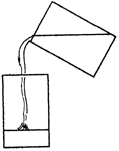Alaska Science Camps, Fairs & Experiments
ANKN is a resource for compiling and exchanging information
related to Alaska Native knowledge systems and ways of knowing. We
are pleased to create and distribute a variety of publications
that assist Native people, government agencies,
educators and the general public in gaining access to the knowledge
base that Alaska Natives have acquired through cumulative experience
over millennia.
TO ORDER THIS PUBLICATION:
Contact the ANKN
offices at 907-474-1902 or email uaf-cxcs@alaska.edu.  Solution
vs Solution
vs
Suspension
Many of Alaska's rivers contain
large
amounts of river silt. Of the Tanana it is said, "It's too thick to
drink and too thin to plow." Many of our islands and riverbanks are
made of silt that has been carried downstream for thousands and
thousands of years.
When a substance is dissolved in a liquid, like sugar in coffee,
the substance remains in the liquid. It is a solution.
When a substance is floating around in a liquid, held there by
current or turbulence, it is a suspension. It will eventually
settle if the water is still.
The Yukon is a mighty river, yet ocean boats cannot enter the
mouth. Why? There has been too much silt deposited in the mouth. We
often talk about the Yukon-Kuskokwim (Y-K) Delta. A delta is the land
formed by the deposit of silt in a river mouth. The current has
slowed as it bucks the tides, and the silt comes out of suspension
and settles.
Heat water in a clear Pyrex container. Pour in measured amounts of
sugar while stirring until it can hold no more sugar. It is now
saturated with sugar. Pour the liquid off the top into another
container.
As long as the water is kept at that temperature, all the sugar
remains in solution.
Now cool the sugar water. What happens? What conclusions can you
draw about the ability of water to hold dissolved sugar? Heat it
again. Does the sugar again dissolve?
Can you taste the difference in the amount of sugar dissolved in
the hot and cold water?
Pass the water containing dissolved sugar through a coffee filter.
Is the sugar filtered out? By taste, compare some filtered sugar
water with unfiltered sugar water.
You might try some of the above activities with salt. Is sugar the
only substance that will dissolve in water?

|
|
SEDIMENT
|
SUSPENSION
|
Collect river water from a silty river. Let the water sit
overnight. What happens to the silt? Stir it up again. Let it settle.
What conclusions do you draw?
Heat the water in a clear container and keep it heated with an
alcohol lamp or other heat source. Let the silt settle. Does the
temperature of the water influence the amount of silt that can be
held in suspension? Or is that influenced by the motion of the
liquid?
Pass silty water through a coffee filter. How much of the silt
passes through the filter? Let the filtered water settle for a while.
Can you see the silt in the filter?
Boil silty water. Does the silt settle faster in boiled water than
in cold water that hasn't been boiled?
If you are able, obtain silt samples from upstream, middle
region
and downstream of a large river. What are the differences? How can
you explain this?
Your Conclusions
From the above experiments, what can you say is the difference
between a solution (being dissolved in a liquid) and a
suspension?
How are river deltas formed?
|